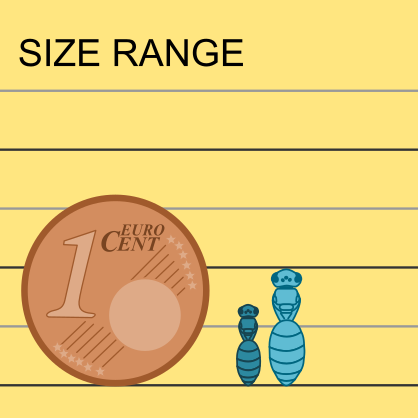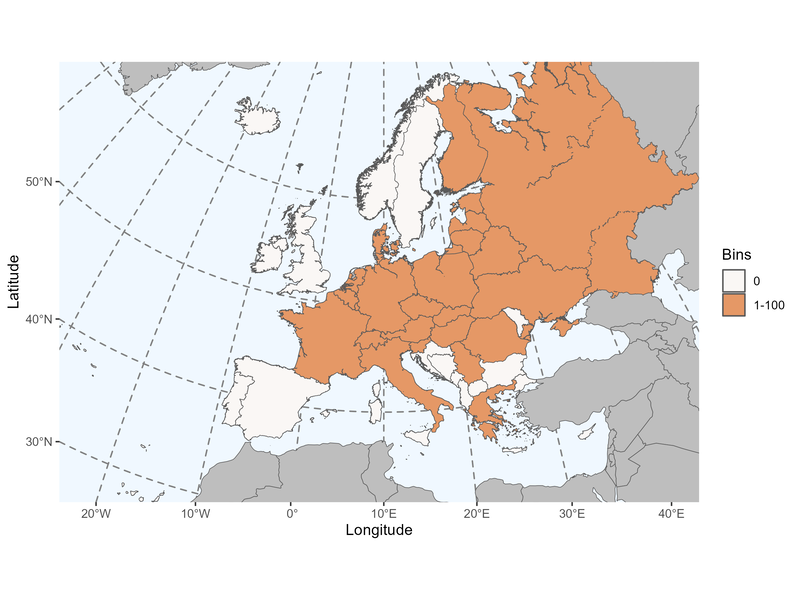Author: Giraud, 1863
|
Type species: Epeoloides ambiguus Giraud, 1863 = Apis coecutiens Fabricius 1775, monobasic.
Synonyms: Viereckella Swenk, 1907. |
Clade: Anthophila
Family: Apidae Subfamily: Nomadinae Tribe: Osirini |
|
Distinctive traits
|
Pictures of distinctive traits
(Sorry, there is no picture available at this time. If you have some and would like to become a contributor to IDmyBee, please contact us.) |
Morphologically close genera, and how to distinguish them:
Epeolus & Triepeolus species have toothed axilae and a postfurcal nervulus.
Nomada species have a marginal cell pointed following the wing's anterior margin.
Melecta and Thyreus species have a scutellum with two teeth or flat with an apical crest, and are mostly black with white pilosity.
- Epeoloides - Epeolus & Triepeolus
Epeolus & Triepeolus species have toothed axilae and a postfurcal nervulus.
- Epeoloides - Nomada
Nomada species have a marginal cell pointed following the wing's anterior margin.
- Epeoloides - Melecta & Thyreus
Melecta and Thyreus species have a scutellum with two teeth or flat with an apical crest, and are mostly black with white pilosity.
General comments on Epeoloides species identification
The genus Epeoloides is represented by a single species in Europe.
The genus Epeoloides is represented by a single species in Europe.
Epeoloides species found in Europe (Ghisbain et al. 2023)
Epeoloides coecutiens (Fabricius, 1775)
Epeoloides coecutiens (Fabricius, 1775)
Online resources:
Atlas hymenoptera (World & Belgium)
Discover Life (World)
WestPalBees (West Palearctic)
Atlas hymenoptera (World & Belgium)
Discover Life (World)
WestPalBees (West Palearctic)
Page contributors:
You noticed a mistake? You have a suggestion to improve this page?
Don't keep it to yourself, contact us and become a contributor to IDmyBee!
References used to write this page:
- Adrien Perrard (Dec. 2023)
- Adrien Perrard (Dec. 2019)
You noticed a mistake? You have a suggestion to improve this page?
Don't keep it to yourself, contact us and become a contributor to IDmyBee!
References used to write this page:
- Ghisbain, G., Rosa, P., Bogusch, P., Flaminio, S., Le Divelec, R., Dorchin, A., Kasparek, M., Kuhlmann, M., Litman, J., Mignot, M., Müller, A., Praz, C., Radchenko, V.G., Rasmont, P., Risch, S., Roberts, S.P.M., Smit, J., Wood, T.J., Michez, D. & Reverte, S. (2023). The new annotated checklist of the wild bees of Europe (Hymenoptera: Anthophila). Zootaxa, 5327(1), 1-147.
- Michener, C.D. 2007. The Bees of the World, 2nd Edition. The John Hopkins University Press, Baltimore.
- Michez D., Rasmont P., Terzo, M., Vereecken, N. 2019. Abeilles d'Europes. Hymenoptères d'Europes, Volume 1. N.A.P. Editions.
- Nieto, A., Roberts, S. P., Kemp, J., Rasmont, P., Kuhlmann, M., García Criado, M., ... & Michez, D. 2014. European red list of bees. Luxembourg: Publication Office of the European Union, 98. (IUCN 2014)
- Rasmont, P., Devalez, Jelle, Pauly, A., Michez, D. & Radchenko, V.G. 2017. Addition to the checklist of IUCN European wild bees (Hymenoptera: Apoidea). Annales de la Société entomologique de France 53: 17-32.



